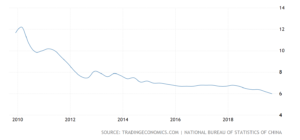We’ve been observing the ebb and flow of trade negotiations between China and the United States with anxiety, hope and curiosity.
The “trade war” — fought as mental combat, not physical combat — has been one of the most important influencers of markets this year and will likely continue to be in 2020. When hope for a deal ebbs, markets react negatively. When hope flows, markets react positively. As they did repeatedly in 2019.
A deal could greatly benefit the economies of both countries, but it’s not surprising that a deal hasn’t been reached, as both sides want more than the other side is willing to give. It may be, too, that China is biding its time in the hope that the next administration will be less concerned about the trade deficit between the two countries.
Nonetheless, there is much at stake, as the two countries have the world’s largest economies.
“The U.S. has retained its position of being the world’s largest economy since 1871,” according to Investopedia. “The size of the U.S. economy was at $20.49 trillion in 2018 in nominal terms and is expected to reach $21.35 trillion in 2019.”
China’s nominal gross domestic product (GDP) is $13.41 trillion, making it second to the U.S., but its GDP based on purchasing power parity (PPP) is $25.27 trillion, exceeding that of the U.S. Then again, China is known for exaggerating its growth, so the numbers may not be accurate. Still, it has grown tremendously since 1980, when it had the world’s seventh largest economy.
With a population of 1.43 billion people, compared with about 329 million in the U.S., China has a population that’s more than four times the size of the U.S. population. American companies that need to continue growing have become dependent on the world’s largest consumer market. China, meanwhile, needs America’s technology and innovation.
Capitalism vs. Socialism
Capitalism has given the U.S. economy a huge advantage, in spite of China’s vast population, while communism has largely held back Chinese economic development. That’s changed significantly over the past 50 years, as the Communist Party began to lift some state controls to save China’s failing economy after the death of Communist Party Chairman Mao Zedong.
While 45 million people starved to death in China between 1958 and 1962 under Mao, China’s decision to de-collectivize agriculture enabled the country to feed itself.
“Long before the official ban on private farming was lifted in 1982, peasant-led initiatives to reintroduce private ownership against socialist doctrine sprang up across China,” Rainer Zitelmann wrote in Forbes. “The outcome was extremely successful: people were no longer starving and agricultural productivity increased rapidly. By 1983, the process of de-collectivizing Chinese agriculture was almost complete. Mao’s great socialist experiment, which had cost so many millions of lives, was over.”
Under Deng Xiaoping, who led the People’s Republic of China from 1978 to 1992, China adopted “socialism with Chinese characteristics.” The country became open to foreign investment and permitted entrepreneurs to start their own businesses, even as most industry remained state-owned.
During the late 1980s and 1990s, China privatized some businesses, contracting out much of what had been state-owned industry, and lifted price controls and many regulations. As a result, by 2005 the private sector accounted for about 70% of China’s GDP.
From 1978 until 2013, unprecedented economic growth occurred, averaging 9.5% a year, even though Deng’s successor Hu Jintao reversed some reforms and regulated business more heavily.
Meanwhile, since the 1960s the U.S. economy has increasingly become more of a mixed economy with increasing government regulation, “in order to achieve social aims and for the public good,” according to Investopedia. The government, for example, subsidizes and provides tax incentives for some businesses, while requiring many businesses to be licensed and to meet regulatory requirements that slow growth.
China’s relationship with free-market economics has been a rocky one, but today China is the world’s leading exporter. And, for the first time, Chinese businesses outnumber American businesses on Fortune’s 2019 Global 500 list, which ranks the world’s largest companies based on revenue.
Slowing Growth
Still, economic growth in China fell sharply during the last years of President Hu’s leadership and GDP has continued to fall under China’s current leader, President Xi Jinping. As we previously wrote, 3% growth is good in the U.S., while recent growth of 6.4% in China is considered insufficient, because China is a developing country and has a lot of catching up to do. We also noted that China exaggerates its growth by about 2% a year.
One reason economic growth is slowing in China is that the government is still heavily involved with Chinese businesses. “Free markets,” like freedom itself, are still an illusion in China.
Another is that economic growth depends on consumers. When their income increases, they are able to buy more, which causes GDP to increase. While living standards have improved in China, they are still far behind those in the U.S. Gross national income per capita was $16,760 in China and $60,200 in the U.S. as of 2017, according to the World Bank.
In other words, in spite of tremendous economic growth over the past 50 years, per capita income is still 359% higher in the U.S. than it is in China.

